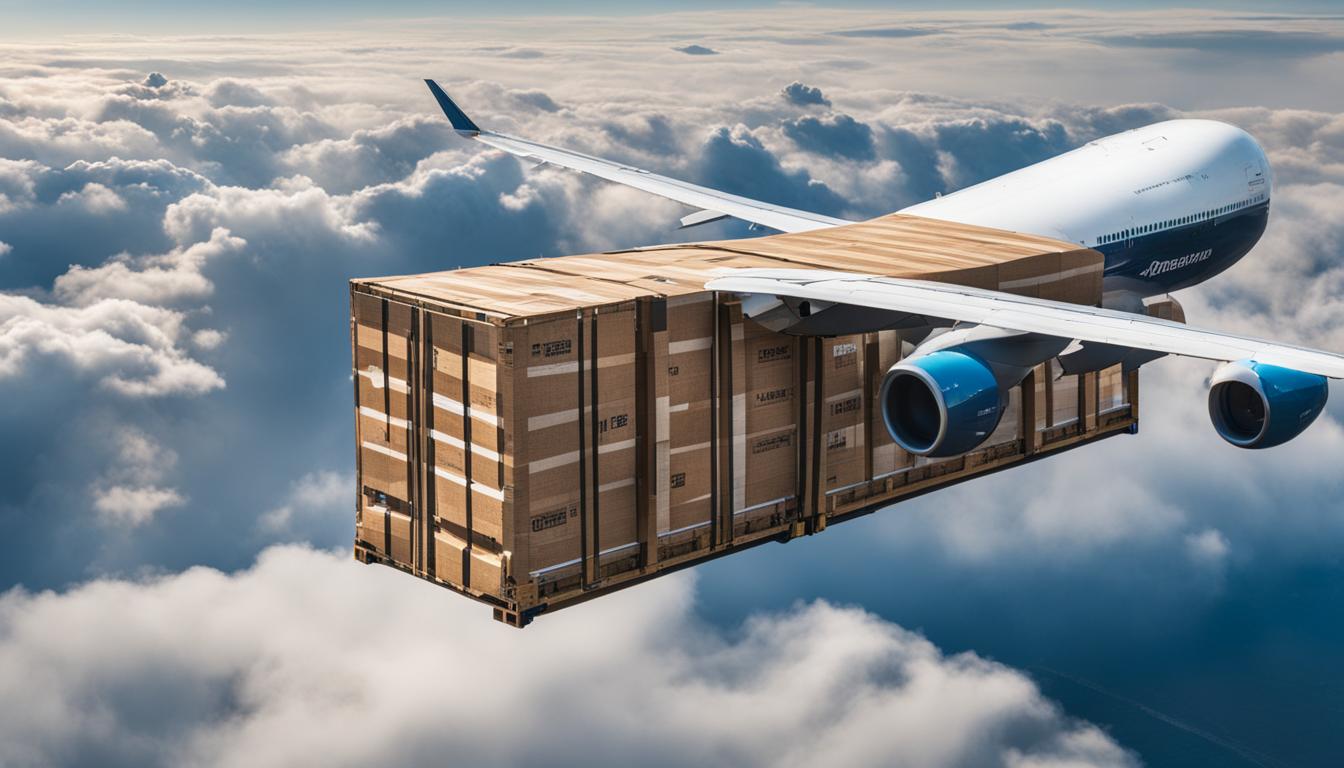In today’s world, businesses are increasingly focusing on sustainable practices throughout their supply chains. Sustainable packaging plays a crucial role in reducing waste, lowering carbon footprint, and optimizing supply chain efficiency. By adopting eco-friendly packaging solutions, businesses can contribute to the conservation of natural resources and enhance global logistics while minimizing environmental impact.
Key Takeaways:
- Airfreight sustainable packaging materials are essential for reducing waste and carbon footprint in the supply chain.
- Eco-friendly packaging solutions contribute to the conservation of natural resources and enhance global logistics.
- Green shipping options, such as environmentally friendly packaging materials, promote sustainability in the airfreight industry.
- Sustainable logistics can be achieved through the adoption of sustainable packaging materials and practices.
- Collaboration with packaging suppliers and optimizing packaging design are crucial for successful implementation of sustainable packaging in airfreight.
The Need for Sustainable Packaging
Traditional packaging materials, such as plastic, have significant environmental impacts. The production and disposal of plastic packaging contribute to resource depletion, greenhouse gas emissions, and excessive waste generation. This has led businesses and consumers alike to recognize the urgent need for sustainable packaging solutions.
Sustainable packaging offers a range of benefits that address these environmental concerns. By using materials that prioritize resource conservation and waste reduction, businesses can lower their carbon footprint and contribute to a more sustainable future. In addition to the positive environmental impact, adopting sustainable packaging can also enhance a brand’s reputation as consumers increasingly seek out eco-friendly practices.
“The environmental impact of traditional packaging materials cannot be ignored. By transitioning to sustainable packaging, businesses have the opportunity to minimize their carbon footprint and make a positive contribution to the environment.” – Sustainability Expert
The Benefits of Sustainable Packaging
One of the key advantages of sustainable packaging is resource conservation. By utilizing materials that are renewable, biodegradable, or recyclable, businesses can reduce their reliance on finite resources and contribute to the preservation of the ecosystem. This not only helps to protect natural habitats but also ensures the availability of resources for future generations.
Another benefit of sustainable packaging is waste reduction. Traditional packaging often ends up in landfills or as litter, causing harm to the environment. Sustainable packaging materials, on the other hand, are designed to break down naturally or be recycled into new products. This significantly reduces the amount of waste generated and helps to close the loop in the circular economy.
Ultimately, the adoption of sustainable packaging not only benefits the environment but also aligns businesses with consumer preferences. As more individuals prioritize eco-friendly practices, businesses that embrace sustainable packaging can build trust, loyalty, and a positive brand image.
| Environmental Impact of Traditional Packaging | Benefits of Sustainable Packaging |
|---|---|
| Resource depletion | Resource conservation |
| Greenhouse gas emissions | Waste reduction |
| Excessive waste generation | Lower carbon footprint |
Sustainable Packaging Solutions
In the quest for sustainable practices, businesses have a range of options when it comes to packaging materials. By choosing biodegradable, recyclable, compostable, or minimalistic packaging, companies can significantly reduce their environmental impact and contribute to a greener future.
Biodegradable Packaging Materials
Biodegradable packaging materials are made from plant-based sources such as cornstarch. These materials break down naturally over time, without causing harm to the environment. By using biodegradable packaging, businesses can minimize waste and reduce their carbon footprint.
Recyclable Packaging Materials
Recyclable packaging materials can be reused to create new products, reducing the demand for virgin materials. By encouraging customers to recycle their packaging, businesses can close the loop and support a circular economy. This not only benefits the environment but also enhances the brand’s reputation as an eco-conscious organization.
Compostable Packaging Materials
Compostable packaging materials are designed to break down in composting systems. These materials support organic waste management and can be a crucial component of sustainable packaging strategies. By using compostable packaging, businesses can contribute to a more efficient and sustainable waste management system.
Minimalistic Packaging
Minimalistic packaging focuses on reducing material consumption while maintaining product integrity and customer experience. By eliminating unnecessary layers and components, companies can significantly reduce waste and optimize their packaging processes. Minimalistic packaging also aligns with the growing trend of eco-conscious consumer preferences for simpler, more sustainable packaging solutions.
| Types of Sustainable Packaging Solutions | Benefits |
|---|---|
| Biodegradable packaging materials | Reduces waste, lower carbon footprint |
| Recyclable packaging materials | Promotes circular economy, enhances brand reputation |
| Compostable packaging materials | Supports organic waste management |
| Minimalistic packaging | Reduces material consumption, optimizes packaging processes |
By adopting sustainable packaging solutions, businesses can make a significant impact in reducing waste, conserving resources, and minimizing their carbon footprint. These environmentally friendly packaging materials not only align with consumer preferences but also support the overall goal of creating a more sustainable and eco-conscious supply chain.
Implementing Sustainable Packaging in Logistics
Implementing sustainable packaging in logistics requires effective collaboration with packaging suppliers, optimization of packaging design, and streamlining of packaging processes. By working closely with packaging suppliers, businesses can identify and source eco-friendly materials that align with their sustainability goals. This collaboration allows for the procurement of packaging materials that are made from renewable resources, biodegradable, recyclable, or compostable.
Optimizing packaging design is another crucial aspect of implementing sustainable packaging in logistics. By designing packaging that is efficient, lightweight, and space-saving, businesses can minimize material consumption and reduce waste throughout the supply chain. This optimization can involve using innovative packaging solutions that require fewer resources while still ensuring product protection during transportation and storage.
Streamlining packaging processes is essential for maximizing efficiency and reducing environmental impact. Automation and technology solutions can play a significant role in achieving this goal. By adopting automated packaging systems, businesses can enhance accuracy, speed, and consistency in packaging operations while minimizing the risk of errors or excess packaging materials. Technology solutions can also enable real-time monitoring and analysis of packaging processes, allowing businesses to identify areas for improvement and implement sustainable packaging practices effectively.
Collaboration with Packaging Suppliers
“Working closely with packaging suppliers is key to implementing sustainable packaging in logistics. By establishing strong partnerships and engaging in open communication, businesses can gain valuable insights into the latest eco-friendly packaging materials and solutions. These collaborations enable businesses to make informed decisions about the most suitable packaging options that align with their sustainability strategies.”
Collaboration with packaging suppliers goes beyond sourcing sustainable materials. It also involves fostering innovation and exploring new packaging designs that reduce waste and improve efficiency. By engaging in a continuous dialogue with suppliers, businesses can stay up-to-date with the latest advancements in sustainable packaging and leverage these innovations to enhance their supply chain sustainability.
| Benefits of Collaboration with Packaging Suppliers | Optimizing Packaging Design | Streamlining Packaging Processes |
|---|---|---|
|
|
|
The Role of FreightAmigo in Sustainable Packaging
FreightAmigo plays a crucial role in promoting sustainable packaging practices and integrating them into the logistics process. Through collaboration with businesses and packaging suppliers, FreightAmigo helps drive the adoption of sustainable packaging solutions, thereby reducing waste and carbon footprint. By working closely with businesses, FreightAmigo assists in identifying eco-friendly materials and exploring innovative packaging designs that optimize sustainability.
Reducing waste and carbon footprint are key objectives for businesses looking to enhance their brand reputation as environmentally conscious organizations. With FreightAmigo’s expertise in sustainable logistics, businesses can achieve their sustainability goals and contribute to a greener future.
By partnering with FreightAmigo, companies can benefit from the knowledge and resources needed to implement sustainable packaging practices effectively. Through streamlined processes and collaboration with packaging suppliers, businesses can reduce packaging waste and optimize their supply chain’s environmental impact. This collaboration not only enhances brand reputation but also aligns with consumer preferences for eco-friendly practices.
The Benefits of Collaboration with FreightAmigo
- Access to a network of eco-friendly packaging suppliers
- Expert guidance on sustainable packaging materials and designs
- Efficient implementation of sustainable packaging practices
- Reduced waste generation and lower carbon footprint
- Enhanced brand reputation as an environmentally conscious organization
“Collaborating with FreightAmigo has been instrumental in our journey towards sustainability. Their expertise in sustainable packaging and logistics has enabled us to reduce waste and lower our carbon footprint significantly. By working together, we have not only enhanced our brand reputation but also contributed to a greener future.” – [Company Name], CEO
FreightAmigo’s commitment to sustainable packaging extends beyond collaboration with businesses. The company also seeks to raise awareness about the importance of eco-friendly packaging solutions and their positive impact on the environment. By championing sustainable logistics, FreightAmigo is driving the industry towards a more sustainable and greener future.
| Benefits of Collaborating with FreightAmigo | Impact |
|---|---|
| Reduced packaging waste | Less environmental impact |
| Lower carbon footprint | Reduced greenhouse gas emissions |
| Enhanced brand reputation | Improved customer perception and loyalty |
Sustainable Logistics: Integrating Packaging and Transportation
Sustainable packaging and transportation are vital components of an environmentally responsible supply chain. By incorporating green transportation practices, efficient route planning, and packaging optimization for transportation, businesses can significantly reduce their carbon footprint and promote sustainable logistics.
Green transportation practices play a crucial role in minimizing emissions and energy consumption. By utilizing alternative fuel vehicles, businesses can reduce their reliance on fossil fuels and decrease their environmental impact. Additionally, adopting efficient route planning techniques helps optimize delivery schedules, minimizing fuel consumption and improving overall transportation efficiency.
Another essential aspect of sustainable logistics is packaging optimization for transportation. By designing packaging solutions that prioritize product protection while minimizing material usage and waste, businesses can further contribute to sustainable practices. This may include utilizing recyclable or biodegradable packaging materials and implementing minimalistic packaging designs that reduce excess packaging and unnecessary materials.
The Benefits of Sustainable Logistics Integration
Integrating sustainable packaging and transportation practices offers numerous benefits for businesses. Not only does it help reduce the overall carbon footprint, but it also enhances brand reputation as a responsible and environmentally conscious organization. Consumers are increasingly prioritizing eco-friendly practices, and aligning with their values can lead to increased customer loyalty and market differentiation.
Furthermore, sustainable logistics integration helps businesses achieve their sustainability goals and contribute to a greener future. By optimizing packaging and transportation processes, companies can improve supply chain efficiency, reduce waste, and conserve resources. These efforts not only benefit the environment but also result in cost savings and increased operational efficiency.
In conclusion, sustainable logistics integration, which includes green transportation practices, efficient route planning, and packaging optimization for transportation, is crucial for promoting environmentally responsible practices in the supply chain. By adopting these practices, businesses can reduce their carbon footprint, enhance brand reputation, and contribute to a more sustainable future.
| Key Elements | Benefits |
|---|---|
| Green Transportation Practices | – Minimize emissions and energy consumption – Reduce reliance on fossil fuels |
| Efficient Route Planning | – Optimize delivery schedules – Minimize fuel consumption and improve transportation efficiency |
| Packaging Optimization for Transportation | – Minimize material usage and waste – Utilize recyclable or biodegradable materials – Implement minimalistic packaging designs |
Conclusion
Sustainable packaging materials are revolutionizing airfreight by reducing waste, lowering carbon footprint, and optimizing supply chain efficiency. Businesses can adopt eco-friendly packaging solutions such as biodegradable materials, recyclable materials, compostable materials, and minimalistic packaging. Collaboration with packaging suppliers, optimizing packaging design, and streamlining packaging processes are key to successful implementation.
FreightAmigo plays a pivotal role in driving the adoption of sustainable packaging practices. By integrating sustainable packaging and transportation, businesses can achieve greater overall sustainability and contribute to a greener future.
In today’s world, where businesses are increasingly focusing on sustainable practices, the use of airfreight sustainable packaging materials is crucial. Eco-friendly packaging solutions provide green shipping options that not only reduce waste and lower carbon footprint but also enhance global logistics while minimizing environmental impact. By adopting environmentally friendly packaging materials, businesses can contribute to the conservation of natural resources and optimize their supply chain efficiency.
With FreightAmigo’s expertise in sustainable logistics and collaboration with businesses and packaging suppliers, the adoption of sustainable packaging solutions is facilitated. This not only helps businesses reduce waste and carbon footprint but also enhances their brand reputation as environmentally conscious organizations. By integrating sustainable packaging and transportation practices, businesses can achieve their sustainability goals and play their part in building a greener future.
- Customer Engagement and Loyalty: Innovating the Future of Saudi Arabia’s Dedicated Cargo Airline - December 23, 2024
- Regulatory and Compliance: Pioneering the Future of Saudi Arabia’s Dedicated Cargo Airline - December 21, 2024
- Financial Strategies: Fueling the Growth of Saudi Arabia’s Dedicated Cargo Airline - December 20, 2024






